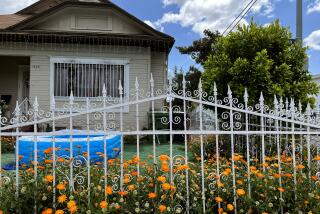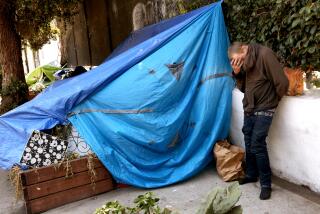Some Gutsy Moves : Veniceâs Most Notorious Neighborhood Lures Home Buyers, Renters
When Francine Vanous bought and refurbished a duplex in the Oakwood section of Venice, one of the first people to greet her was the neighborhood drug dealer.
The young crack peddler approached the demure-looking high school art teacher as she rode her bicycle down the street in broad daylight.
âHe asked me what I needed,â said Vanous, 38. âAnd I told him nothing. You see that a lot here, though I have learned which streets to avoid.â
Criminals in residence arenât usually found in neighborhoods within walking distance of the beach. But in Oakwood, a cramped community of gang kingpins, artists, stockbrokers and petty thieves, such paradoxes abound.
High-cost housing units for upwardly mobile professionals are taking shape in the same area where a 9-year-old boy was gunned down in a gang-related shooting last week. People paying $1,400-a-month rent are living beside welfare families crammed into subsidized housing.
While Oakwood is arguably the most dangerous neighborhood on the Westside--some say the recent killing of little Jorge Gonzalez outside his home is a telling example of the precarious nature of life there--it is also becoming a popular site for adventurous renters and home buyers.
Buyers Plentiful
Larry E. Kincannon, a Jon Douglas Co. real estate broker who specializes in the area, said Oakwood usually appeals to the kind of people who are not sent running by the site of curb-side criminals, junked cars and graffiti. Such buyers, he added, are plentiful in todayâs high-priced housing market.
âEverything really started moving about two years ago,â Kincannon said. âWhat happened was the surrounding areas were going up while Oakwood remained suppressed. And it reached a point where it became worthwhile for people to come in and fix it up, because there is only so much beach-area property.â
Gail Wronsky and Chuck Rosenthal, married college professors who have a 1-year-old daughter, recently purchased a spacious house with a loft in Oakwood for about $200,000 after renting in the area for the last year.
Wronsky said Oakwood, for all its obvious downside, is still one of the best values along the coastline. As ex-Easterners, she said, she and her husband are accustomed to the rigors of an urban environment. On two occasions, she has marched into the street with her daughter on her hip and ordered a drug dealer away from her house.
âWe have been surprised by the amount of public drug dealing going on,â Wronsky said. âBut (otherwise) weâve liked it here from the start. We have a 1,400-square-foot house, and weâre 5 blocks from the ocean.â
Longtime residents, many of them poor blacks and Latinos, know all about Oakwoodâs growing cachet, and some fear that the poor will be washed away in a tide of big bucks and fast talk. They say itâs not uncommon to receive an inquiry a day from real estate brokers offering to put their houses on the market for as much as $250,000, twice as much as they fetched two years ago.
Increasing Pressures
âThe yuppies are coming!,â said Pearl White, sounding like a modern-day Paul Revere. âAnd many are already here. They are buying up everything.â
Margarita Saenz and her family have lived in Oakwood for more than 25 years. Saenz said she has felt increasing pressures from real estate agents interested in moving the 13 members of her family out of their blue-gray Spanish-style house.
âI think what they ought to be doing is helping poor people to stay,â Saenz said. âBecause if all of us are forced out, where will we go?â
People living in federally subsidized apartments are also feeling the pressure. âSome . . . feel threatened,â said Melvin Hayward, a neighborhood activist who manages a subsidized building. âThey know that housing is critical and that this area is getting real popular.â
In fact, Oakwoodâs 10,000 residents are already hemmed in by growth.
To the west, on West Washington Boulevard, is a thriving business community, the gateway to the beach. To the south lies the Marina Peninsula with its million-dollar homes and the bright lights of Marina del Rey. To the east is prime West Los Angeles residential property, and to the north is Santa Monica.
Ghetto Atmosphere
In the past, Oakwood stood apart from those places, as well as from the rest of Venice, because of its ghetto-like atmosphere. If Venice was a carnival, Oakwood was its scariest ride. But the gap is closing, says Los Angeles City Councilwoman Ruth Galanter, who represents the coastal area.
âThere has been much more activity in Oakwood in the last several years than there has been in a long time,â Galanter said. âOakwood was spared in the past because people viewed it as a tough area . . . (but) a lot of people who have been sitting on their property are now starting to build.â
In an effort to control Oakwoodâs growth and calm community unrest, Galanter recently created the Oakwood Community Congress, a group that fights crime while encouraging cooperation between older and newer residents.
Galanter said she hopes that Oakwood will retain its mixed ethnic character, though she conceded that a certain amount of gentrification is inevitable.
Oakwood already has one famous resident, actor Dennis Hopper, who lives in a modern silver fortress designed by Frank Gehry. Hopperâs home, which sits on one of Oakwoodâs worst streets, was recently covered with graffiti.
Elaine Spierer, who works with the Venice-based Rosenthal and Associates Realtors, said all types of people are purchasing Oakwood property, from members of the fashionable art crowd to middle-American style families.
âThere are no land barons here,â Spierer said. âThese are people looking for good values, because prices jump if you go two blocks outside Oakwood.â
As Spierer wheeled her shiny BMW down the street, it was easy to tell where Oakwoodâs borders began. In the outer areas, the streets were lined with well-kept middle- and upper-class homes. In Oakwood, by comparison, many of the houses and apartment buildings were ravaged, and drug dealers dressed in black beckoned to early morning commuters from practically every corner.
âHostile Streetsâ
âThe big negative about Oakwood is that it is still very hostile on the streets.â Spierer said. âYou can feel it. Iâve had some buyers who are fearful. And I tell them, âIf you want white bread, donât buy in Oakwood.â â
Peter Nott, who owns 48 apartment units in Oakwood, a fifth of them usually vacant, said many of his tenants have gotten fed up and have left because of the never-ending parade of drug dealers, muggers and homeless people.
âA lot of my tenants just split,â Nott said. âAnd now itâs difficult to get new tenants in. Many who come by are afraid of the big groups of people they see standing on the corners. . . . Others intend to stay, but after a couple of months of hearing gunshots, helicopters and sirens, they leave.â
Crime has long been one of Oakwoodâs major industries. Residents periodically take to the streets to protest, as they did in 1986, when groups marched nightly chanting âNope to Dope!â and âUgh to Drugs!â But itâs an uphill battle. Capt. John R. Wilbanks of the Pacific Division said Oakwood still ranks as one of the cityâs prime drug-peddling havens.
In the last 18 months, police have beefed up patrols and made more than 2,000 arrests there without really making a dent in the drug traffic, Wilbanks said.
âWe have more cars assigned to that small area than anyplace else,â he said. âBut we make one arrest and while weâre processing the paper work, more of them are back on the street selling. The criminal activity far outnumbers the officers we have to deal with it at this point.â
In addition to its drug problems, Oakwood also has a history of racially motivated gang warfare that reached its peak in the mid-1970s. While tensions have eased, the area remains racially mixed: 56% Latino, 24% black and 17% white, according to the National Planning Data Corp.
At the same time, however, income is on the rise. The national Planning Data Corp. estimates that 16% of the population lives below the poverty line, compared to 31% in 1980, and that 25% of the households earn more than $40,000 a year, compared to less than 5% in 1979.
Boosters say it is obvious that Oakwood stands for more than crime and despair these days. Peter Trias, a developer who has renovated about 10 buildings there, said he has witnessed enormous changes in the past two years.
âMix of Peopleâ
âThe neighborhood looks worse than it really is,â Trias said. âOnce youâre in there, you realize that there is a whole mix of people and that the criminal element really doesnât seem to affect your life very much.â
Ted Tokio Tanaka, an architect who built a green-and-pink 5-unit apartment building in Oakwood with 11-foot ceilings, skylights and concrete floors, said tenants are fairly easy to find, even at $1,400 a month.
âI wanted to do something cheerful, because the neighborhood isnât too hot,â Tanaka said. âWe get top dollar in rent because of the design.â
The RAMM Partnership, a development company based in Venice, recently started renovating two small duplexes in Oakwood. Cheryl Noble, the chief executive officer, said the two properties will be priced at about $570,000.
Noble said the group, composed of Robert Winters, Andrew Gillespie, Michael Zacha and Michael Dieden, hopes to do more development in Oakwood. âAs new owners are coming in, they are making the properties look nicer, and a sense of community pride is developing,â she said. âOakwood is desirable.â
Subsidized Units
For many newcomers, the ultimate hope is that Oakwood will be fully redeveloped. But a major obstacle, from their viewpoint, is the U.S. Department of Housing and Urban Development, which controls 246 federally subsidized apartment units in Oakwood.
HUD spokesman Scott Reed said the contract on Oakwoodâs subsidized units expires in 1992, but no one seems to know what will happen next, since the government may be interested in maintaining the low-cost housing. âThat question is under review,â Reed said, âbut no decision has been made.â
Those doubts have made residents uneasy. Last month, they met with with Alliance Housing Management Inc., which controls the apartments under a HUD contract, but company President Jack Taren was playing it close to the vest.
Taren would say only that the limited partnership is exploring its options, one of which is getting out from under the HUD contract by paying off its mortgage. âAt this point in time, weâre not sure what options can be exercised,â Taren said. âWe donât know the answers.â
If the Oakwood subsidy program ended, Reed said, displaced tenants would receive relocation vouchers. But the loss of the 246 apartment units would be a devastating blow on the Westside, where low-cost housing is already severely limited and lines for open units are long. Taren said he is no longer taking applications for his bigger units because the wait often exceeds five years.
Francine Vanous, tucked away in her comfortable duplex with its glossy hardwood floors, its throw rugs and its subdued yellow walls, said she has no idea what the future holds for Oakwoodâs subsidized housing. But she will be surprised if the community doesnât change over the long haul.
In the meantime, Vanous said, newcomers would be wise to develop some street smarts. âYou just have to make sure youâre not in the wrong place at the wrong time.â
More to Read
Sign up for Essential California
The most important California stories and recommendations in your inbox every morning.
You may occasionally receive promotional content from the Los Angeles Times.






